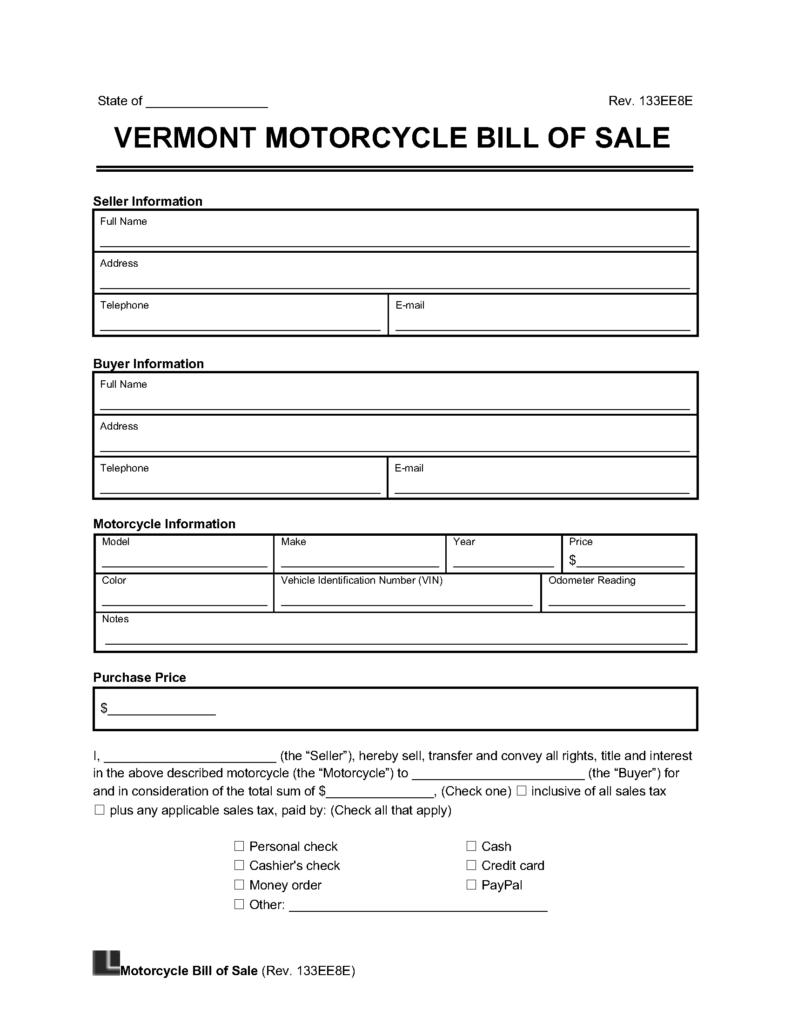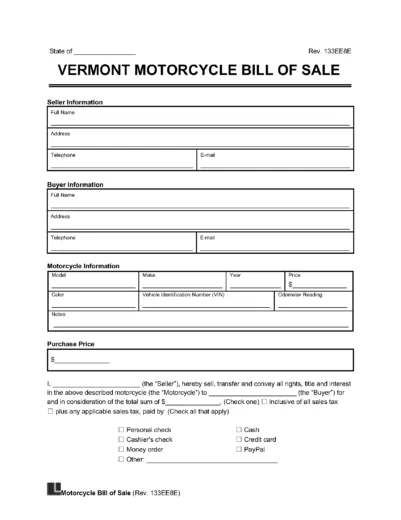A Vermont Motorcycle Bill of Sale is necessary when transferring motorcycle ownership. An attached odometer disclosure statement must also accompany this form.
What is a Vermont Motorcycle Bill of Sale Form?
A motorcycle bill of sale details an agreement for the purchase and sale of a motorcycle.
It records the ownership transfer of a motorcycle from the seller to the buyer and provides details about the parties, motorcycle, purchase price, and sale date.
If the vehicle has been salvaged or rebuilt, the seller must complete a related section and the buyer must acknowledge those details.
Both the buyer and seller must sign the bill of sale. A bill of sale must accompany all motorcycle transfers, even if the buyer has the original title.
Is a Motorcycle Bill of Sale Form Required in Vermont?
Yes, a motorcycle bill of sale form is necessary for motorcycle sales in Vermont.
Generally, for dealer sales, the dealer will provide the bill of sale for Purchase and Use Tax purposes.
For private and out-of-state sales, the seller will give the bill of sale to the buyer to transfer the title.
Do You Need a Bill of Sale to Register a Motorcycle in Vermont?
In Vermont, you will need a bill of sale for registration with the Vermont Department of Motor Vehicles (DMV) for almost all motorcycle purchases, including those between private parties.
How Do I Transfer Ownership of a Motorcycle in Vermont?
The buyer is responsible for submitting all documents for transferring title and registration. You must submit the following documents:
- Properly assigned Certificate of Title (all owners listed on the title must sign as sellers in the assignment of ownership section on the back of the title and the buyer’s name must be on the “transferred to” line)
- Manufacturer’s Certificate of Origin (only for new motorcycles that have not been previously titled or registered)
- Bill of Sale and Odometer Disclosure Statement (VT-005)
- Vermont Registration, Tax, and Title Application (VD-119)
- Vehicle Identification Number (VIN) verification if the title is branded Salvage
- All required taxes and fees
If registering by mail, include the NADA value printout available at the Vermont DMV website.
You can mail the registration documents can to:
Vermont DMV
120 State Street
Montpelier, Vermont 05603-0001
If your vehicle requires a VIN inspection, you can make an appointment at the DMV to complete it.
Motorcycle Title Transfer With a Bill of Sale Only
You can transfer the title with only a bill of sale in Vermont if the motorcycle is more than 15 years old.
If the bike is newer than 15 years, you will need to apply for a replacement title.
You can use the bill of sale to apply for a new title along with a Replacement Title Application (VT-004) if the original title has been lost, stolen, destroyed, or defaced.
Does a Vermont Motorcycle Bill of Sale Need to Be Notarized?
The Vermont motorcycle bill of sale is not legally required to be notarized.
However, the buyer or seller may want the document notarized if they wish for additional legitimacy and legal protection.
Buying and Selling a Motorcycle in Vermont
Step 1 – Preparing Your Motorcycle for Sale
Make sure your motorcycle is mechanically sound, clean, and detailed.
Even if you sell the bike “as-is,” it should be operable. Vermont specifically brands salvaged motorcycle titles, so be cautious about buying or selling any motorcycle that has been salvaged or totaled.
Buyers should take the motorcycle to a mechanic before exchanging payment for it.
“As-is” or used sales are generally considered final unless there is evidence of fraud.
Step 2 – Determining the Value of Your Motorcycle
Check price guides like Kelley Blue Book or JD Power and review local sales listings before posting your motorcycle for sale.
You should know your motorcycle’s value and what local buyers are paying. This will help you when it’s time to negotiate a price for your bike.
Step 3 – Advertising Your Motorcycle
Online marketplaces, newspapers, and forums are best for local sales.
In addition, motorcycle shops may allow you to post flyers or ads. If you have a vintage or specialty bike, such as a Harley or a racing bike, you may want to post ads on national websites or have a broker oversee the sale to get a better price.
If you don’t want to haggle, your ad should say “firm price” or “fixed price.”
If you want to sell your motorcycle quickly, you can say “or best offer” or “OBO” so that you don’t need to argue up and down with buyers.
Step 4 – Meeting with the Potential Buyer
Negotiations for price and transfer date should occur in public during the day.
Unless you already know the buyer, try to avoid exchanging the payment and the motorcycle the first time you meet them.
Buyers may wish to conduct a test drive. Ideally, this happens in an enclosed space or parking lot.
If you’re not mechanically savvy, have a mechanic or a friend who knows motorcycles come with you.
How to Write a Motorcycle Bill of Sale in Vermont (What to Include)
A Vermont motorcycle bill of sale includes pertinent information about the buyer, the seller, and the motorcycle.
Step 1 – Fill in Buyer and Seller Information
Your motorcycle bill of sale for Vermont should include the following information about both the buyer and seller:
- Full name or individual or business entity
- Address
- Phone number
Step 2 – Fill in Motorcycle Information
All relevant information about the motorcycle itself should be on the Vermont bill of sale, including the following:
- Year, make, and model
- Body type
- Color
- VIN
- Odometer Reading (miles/kilometers, no tenths)
Step 3 – Odometer Disclosure Information
The Odometer Disclosure Statement is on the back of the Bill of Sale and Odometer Disclosure Statement (VT-005).
You must submit this information for all vehicles of model year 2011 and newer, self-propelled, or with a registered weight of 16,000 pounds or less.
Summary
You can find a fill-in motorcycle bill of sale template on Legal Templates.
Vermont Motorcycle Bill of Sale Sample
Below is an example of a Vermont motorcycle bill of sale form.



